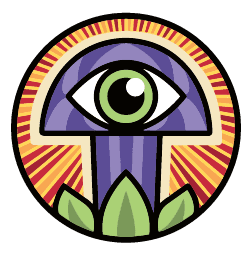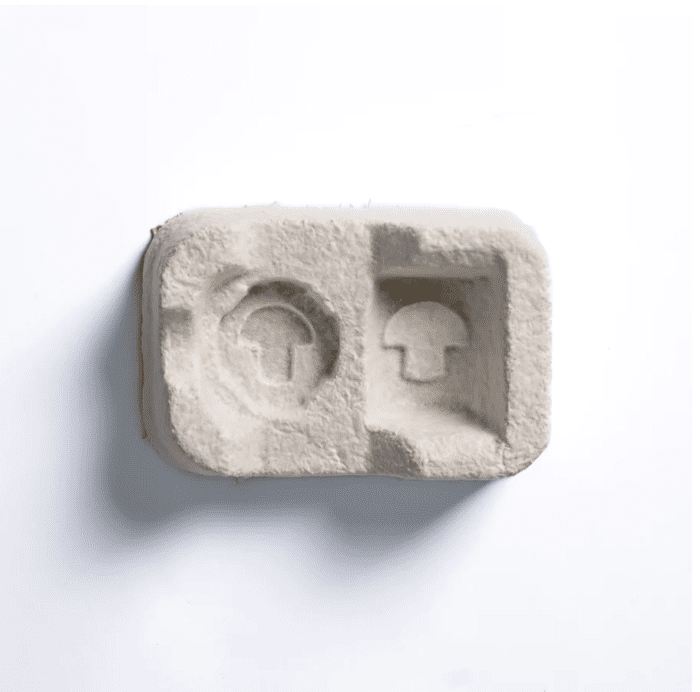Imagine sitting down to a delicious meal with bacon made from mushroom mycelium in your mycelium insulated home. There’s a knock at your door – a delivery man with your latest online purchase. You hastily remove the mushroom mycelium packaging to find your favorite new mycelium leather shoes. To show off your new regenerative kicks with your friends, you snap a photo with your phone that’s powered by mycelial hyphae.
Seem unrealistic? Make no bones about it, this fictitious story may soon be a reality.

Welcome to our first Fungi on the Fringe article! In this series, we’ll cover all the innovations and developments occurring on the fungal fringes. This week, we’re focusing on new mushroom mycelium technologies being developed to enhance our lives and revolutionize our most destructive industrial processes.
Join us and our fungal friends as we outline five mind-melting mushroom mycelium materials transforming our world!
Mushroom Mycelium Mansions
Have you ever looked at a mushroom and thought, “Let’s build a house!” Me neither.
Nonetheless, there are some seriously imaginative people using mycelium to create all kinds of structures. These materials, dubbed mycocomposites, use a rather straightforward process to develop products like mushroom mycelium mycobricks, surfboards, canoes, furniture, acoustic paneling, packaging materials and more. The latter, in particular, could soon make styrofoam obsolete.
Heck, the process is so simple, we’ll explain it here:
Fill a mold with a substrate and inoculate it with the best mushroom mycelium for the job. Here, the mushroom species you choose will alter your final product.
For example, Reishi mushroom mycelium (Ganoderma spp.) is quite hard and sturdy but still retains some softness. Can you say mushroom mycelium acoustic panels?
On the other hand, Oyster mushroom mycelium (Pleurotus spp.) is a bit softer and more squishy; a great option to take a load off in an Oyster mushroom mycelium chair after a long day.
The substrate you choose matters, too. Looking for an optimal building material? Hemp husks work great for creating mushroom mycelium bricks, which are lightweight, durable, stronger than concrete, fireproof, and most importantly for mass production, CHEAP!
By now, you’re hopefully seeing the potential: instead of extracting resources from the Earth, we can build shelters using waste products. In the process, we’d save truckloads of money, energy and environmental destruction. We’d also end up with homes that can naturally return to the soil and Earth at the end of their useful life.
This, my friends, is the definition of a circular economy and the massive potential of mushroom mycelium building materials, AKA mycomaterials!
Mushroom Mycelium Leather
Now that we’ve tackled building, let’s look to the future of fashion.
Fast fashion and leather production are exploitative of humans, animals and pachamama. Mushroom mycelium leather is about to change all of that. Heck, it already is.
Companies like Mylo are leading the charge, partnering with corporate giants like Adidas, Stella McCartney and Lululemon to create mushroom mycelium shoes, yoga mats and runway robes.
Ecovative is another company to watch with a mushroom mycelium leather production process that’s 100% vegan and plastic-free and creates a comparable product to animal leather in just 9 days. Plus, by ceasing leather production, we’ll also stop using harmful chemical sprays.

In this process, Reishi mushroom mycelium is the go-to but other species like Amadou (Fomesfomentarius) can produce unique materials similar to suede, as Paul Stamets likes to show off in his horseshoe fungus hat.
In all, the benefits of substituting mushroom mycelium for leather are practically endless. But it’s on all of us to support these companies and change the demand.
So next time you need a new hat, jacket, or shoes, put your dollars to work and gear up in Ganoderma!

Try our Fungal Ecology Course for FREE
Mushroom Mycelium Meat
As we already mentioned, the ‘AirMycelium’ product Ecovative creates is often used to mimic leather products. But this unique technology, actually a form of natural foam, has many other applications.
By now, it’s common knowledge that meat produced for consumption on an industrial scale is incredibly damaging for the planet and our bodies. As such, more and more people are choosing a plant-based diet. But we need to change the name to a plant AND FUNGI based diet, we think.
Why?
Because mushroom mycelium is about to take over the meat alternative market. Until now, much of mushroom mycelium’s contribution here has been to build tissue-like scaffolding in imitation meats.
But AirMycelium takes a different approach, instead using mushroom mycelium as the faux-meat cutlet. And to this end, gourmet mushrooms are already well-equipped, as they’re one of the richest non-animal sources of umami—the fifth basic taste— in the world. That, my friends, is yet another fungal application contributing to the Shroom-Boom!
MycoPhone
Our current addiction to technology and rare metals needed for their production is killing the world and its peoples.
Yet there’s hope: A growing number of tech companies are looking to mushroom mycelium hyphae as the next conductors. Mycelium is just one biological material being prototyped for its use in electronics as visionaries look to build a future where our technologies work in symbiosis with organic matter instead of systematically destroying it.
Most of this work is in the speculative stage, yet fungal composites are already being used to prototype circuit boards and reduce plastic waste.
Not that this should surprise anyone. In the mind-bending book Entangled Life by Merlin Sheldrake, the computing power of mycelium is explored as the means by which nutrients, DNA, biochemical signals, poisons, hormones and other information are exchanged between plants and fungi via mycorrhizal mycelial networks, also known as the Wood Wide Web.
If humans weren’t so late to this fungal renaissance, perhaps we’d be calling the Internet “the Mycelium” instead.
Papier Mâchroom
Just when you think it can’t get any stranger, you learn that you can make a book from mushrooms – ink and all.

In the aforementioned Entangled Life, the illustrations were drawn using the Ink Cap mushroom (Coprinus comatus), a proof of concept that mushrooms can be leveraged as a source of natural, sustainable pigments and dyes to color our world.
But the real planet-saving power may come from using mushroom mycelium to create the paper itself.
The birch polypore mushroom (Fomitopsis betulina) and other white bracket fungi are favorite specimens for this process, but much of the experimentation is with Oyster mushrooms because of their resilience and ease of use.
Oysters are also being used to clean up our paper production mess, transforming pulp into new products like a fungal goo that can be used in 3D printers. When applied, this material can be used to create complex modular structures that slowly grow together to fill in the gaps! People are already using 3D printers to build houses – might this technology lead to the first mushroom mansion?
The Future is Fungal
Fungi have been radically shaping our natural world for millions of years. Now, we humans are finally starting to recognize them as a vital ally in constructing a new reality. Using mushroom mycelium to create new technologies and materials couldn’t come at a better time.
So, how can you help? Spread the word! Vote with your dollar!! Research and experiment to help further develop these organic technologies.
And tell all your friends: the future is fungal!
about the author
Colin first discovered the world of fungi through his interest in permaculture. The more he learned, the more he became mesmerized by mushrooms. This first lead him to the Fungi Academy in his van in the spring of 2020 where spent 10 weeks discovering another home outside his native Canada. A year later, Colin returned to take over Community Manager duties at the academy. A self-proclaimed nerd, he is fascinated by the potential of community life, mycoremediation, mycofiltration and psychedelic assisted therapy to help change the world.



